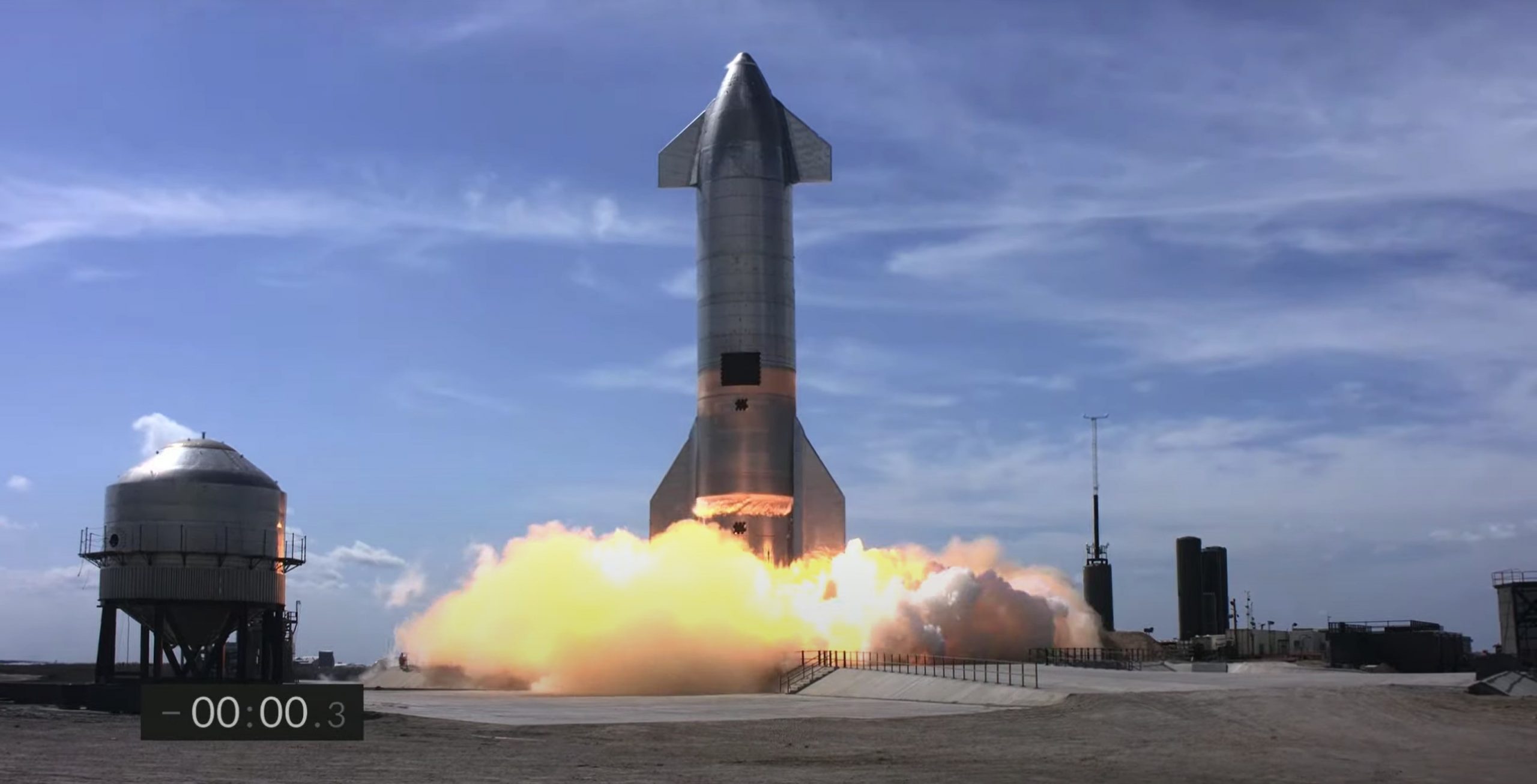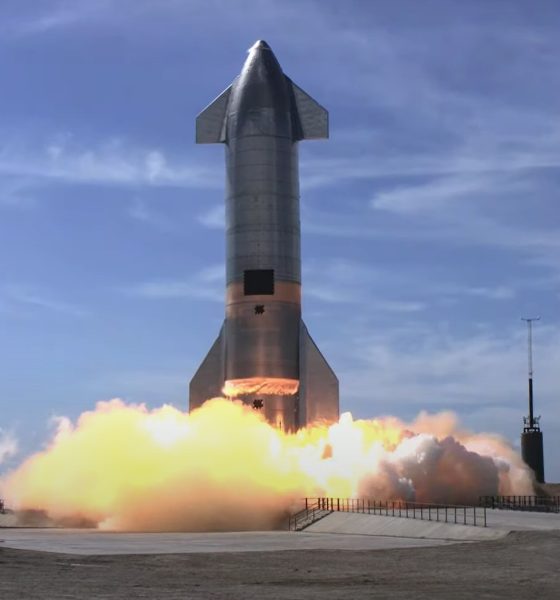

News
SpaceX aborts Starship launch after Raptors produce too much thrust
Update #3: SpaceX CEO Elon Musk says that Starship prototype SN10 automatically aborted a 2:15 pm CST (UTC-6) launch attempt after the rocket determined that its three Raptor engines were producing too much thrust.
Instead of scrubbing for the day, Musk says that SpaceX will instead increase the flight computer’s thrust limits and try again as early as 4:30 pm CST – still well before today’s window closes at 6:30 pm. SpaceX ended its webcast but will start a second webcast a few minutes prior to the next launch attempt.
Update #2: As of Wednesday morning, SpaceX has officially confirmed that Starship is on track for a third high-altitude launch and ‘bellyflop‘-style landing attempt sometime later today.
As of 11am CST (UTC-6), FAA approval is in hand, weather is encouraging, Starship prototype serial number 10’s (SN10) flaps have been unchained, and SpaceX has cleared the launch site – all signs that the rocket’s launch attempt is imminent. Much like SN8 and SN9 coverage, SpaceX says it will make a public livestream of SN10’s launch available to the public “a few minutes” before liftoff. Stay tuned and follow along with NASASpaceflight’s live coverage in the meantime.
Update: SpaceX has asked Boca Chica Village residents to prepare to evacuate the area as early as Wednesday morning for Starship’s third high-altitude launch and landing attempt.
The odds of things going so wrong that a Starship launch could actually end with a prototype impacting at or near the Village and the handful of non-employee holdouts still residing there are minuscule. However, FAA safety regulations and SpaceX’s contingent launch license mean that evacuations are now a routine part of Starship’s high-altitude flight tests since Starship SN8 took the first step beyond short hops. While undeniably inconvenient for the few remaining residents, today’s evacuation notice – short of an official SpaceX.com confirmation – does serve as the ultimate sign that Starship SN10’s first launch attempt is firmly scheduled on Wednesday, March 3rd.
With FAA approval in hand, weather rapidly improving, and the latest rocket prototype seemingly raring to go, the stars are aligning for SpaceX’s third high-altitude Starship launch and first triple-engine landing attempt.
As of March 1st, publicly-available FAA “temporary flight restrictions” (TFRs) and weather forecasts both agree that SpaceX is currently preparing to launch Starship serial number 10 (SN10) as early as Wednesday afternoon CST (UTC-6), March 3rd. Barring surprises, that gives SpaceX a healthy three-day period to account for any potential technical or weather-related delays.
Originally scheduled as early as the last week of February, unspecified delays pushed Starship SN10’s launch debut schedule into March. In general, the vehicle’s path to flight has been much smoother than Starship SN8 and SN9, both of which ran into hardware bugs and opaque FAA licensing issues. With Starship SN10, the FAA approved SpaceX’s “modified” launch license well before the company was ready for flight – and even before the rocket had attempted its first static fire.
Unlike Starships SN8 and SN9, both of which took anywhere from 6-10 weeks to go from rolling off the factory floor to preparing for their first launch attempts, SN10’s first launch attempt appears likely to occur less than five weeks after the rocket arrived at the launch site. The sequential improvements in efficiency and reliability between those three prototypes is a fundamental part (or goal, at least) of SpaceX’s iterative development process.
Still, Starship SN10’s preflight flow wasn’t completely free of drama and SpaceX ultimately put the rocket through a second triple-Raptor static fire after the first test revealed an issue with one of those engines. SpaceX swapped that faulty engine out in record time and fired up SN10 again less than 48 hours after test #1, seemingly producing more satisfactory results the second time around.
Unlike its predecessors, SN10 will also debut a new triple-engine approach to landing, aiming to increase redundancy and boost the odds of a successful touchdown even if one of the Starship’s three Raptors fail during a last-second flip maneuver. Building on the failures of SN8 and SN9, it’s safe to say that SN10 has the best shot yet at sticking the landing.
TFRs show that two earlier launch windows on Monday and Tuesday (March 1st and 2nd) were canceled, leaving only the Wednesday, March 3rd airspace closure request still open. Wednesday was then backed up with two alternate windows on Thursday and Friday not long after.
Hardware-wise, Starship SN10’s cherry-on-top (an explosives-based flight termination system or FTS) was installed on February 28th. In the event that Starship loses control and strays past a certain point outside of its approved trajectory, that FTS would explode, breaching the rocket’s propellant tank, triggering vehicle breakup, and thus preventing it from harming the local populace. All told, SpaceX confirmation of a Wednesday launch attempt – and another official webcast – should be imminent. Stay tuned!

News
Elon Musk’s Grokipedia surges to 5.6M articles, almost 79% of English Wikipedia
The explosive growth marks a major milestone for the AI-powered online encyclopedia, which was launched by Elon Musk’s xAI just months ago.

Elon Musk’s Grokipedia has grown to an impressive 5,615,201 articles as of today, closing in on 79% of the English Wikipedia’s current total of 7,119,376 articles.
The explosive growth marks a major milestone for the AI-powered online encyclopedia, which was launched by Elon Musk’s xAI just months ago. Needless to say, it would only be a matter of time before Grokipedia exceeds English Wikipedia in sheer volume.
Grokipedia’s rapid growth
xAI’s vision for Grokipedia emphasizes neutrality, while Grok’s reasoning capabilities allow for fast drafting and fact-checking. When Elon Musk announced the initiative in late September 2025, he noted that Grokipedia would be an improvement to Wikipedia because it would be designed to avoid bias.
At the time, Musk noted that Grokipedia “is a necessary step towards the xAI goal of understanding the Universe.”
Grokipedia was launched in late October, and while xAI was careful to list it only as Version 0.1 at the time, the online encyclopedia immediately earned praise. Wikipedia co-founder Larry Sanger highlighted the project’s innovative approach, noting how it leverages AI to fill knowledge gaps and enable rapid updates. Netizens also observed how Grokipedia tends to present articles in a more objective manner compared to Wikipedia, which is edited by humans.
Elon Musk’s ambitious plans
With 5,615,201 total articles, Grokipedia has now grown to almost 79% of English Wikipedia’s article base. This is incredibly quick, though Grokipedia remains text-only for now. xAI, for its part, has now updated the online encyclopedia’s iteration to v0.2.
Elon Musk has shared bold ideas for Grokipedia, including sending a record of the entire knowledge base to space as part of xAI’s mission to preserve and expand human understanding. At some point, Musk stated that Grokipedia will be renamed to Encyclopedia Galactica, and it will be sent to the cosmos.
“When Grokipedia is good enough (long way to go), we will change the name to Encyclopedia Galactica. It will be an open source distillation of all knowledge, including audio, images and video. Join xAI to help build the sci-fi version of the Library of Alexandria!” Musk wrote, adding in a later post that “Copies will be etched in stone and sent to the Moon, Mars and beyond. This time, it will not be lost.”
News
Tesla Model 3 becomes Netherlands’ best-selling used EV in 2025
More than one in ten second-hand electric cars sold in the country last year was a Tesla Model 3.

The Tesla Model 3 became the most popular used electric car in the Netherlands in 2025, cementing its dominance well beyond the country’s new-car market.
After years at the top of Dutch EV sales charts, the Model 3 now leads the country’s second-hand EV market by a wide margin, as record used-car purchases pushed electric vehicles further into the mainstream.
Model 3 takes a commanding lead
The Netherlands recorded more than 2.1 million used car sales last year, the highest level on record. Of those, roughly 4.8%, or about 102,000 vehicles, were electric. Within that growing segment, the Tesla Model 3 stood far ahead of its competitors.
In 2025 alone, 11,338 used Model 3s changed hands, giving the car an 11.1% share of the country’s entire used EV market. That means more than one in ten second-hand electric cars sold in the country last year was a Tesla Model 3, Auto Week Netherlands reported. The scale of its lead is striking: the gap between the Model 3 and the second-place finisher, the Volkswagen ID3, is more than 6,700 vehicles.
Rivals trail as residual values shape rankings
The Volkswagen ID.3 ranked a distant second, with 4,595 used units sold and a 4.5% market share. Close behind was the Audi e-tron, which placed third with 4,236 registrations. As noted by Auto Week Netherlands, relatively low residual values likely boosted the e-tron’s appeal in the used market, despite its higher original price.
Other strong performers included the Kia Niro, the Tesla Model Y, and the Hyundai Kona, highlighting continued demand for compact and midsize electric vehicles with proven range and reliability. No other model, however, came close to matching the Model 3’s scale or market presence.
News
Tesla Model Y Standard Long Range RWD launches in Europe
The update was announced by Tesla Europe & Middle East in a post on its official social media account on X.

Tesla has expanded the Model Y lineup in Europe with the introduction of the Standard Long Range RWD variant, which offers an impressive 657 km of WLTP range.
The update was announced by Tesla Europe & Middle East in a post on its official social media account on X.
Model Y Standard Long Range RWD Details
Tesla Europe & Middle East highlighted some of the Model Y Standard Long Range RWD’s most notable specs, from its 657 km of WLTP range to its 2,118 liters of cargo volume. More importantly, Tesla also noted that the newly released variant only consumes 12.7 kWh per 100 km, making it the most efficient Model Y to date.
The Model Y Standard provides a lower entry point for consumers who wish to enter the Tesla ecosystem at the lowest possible price. While the Model 3 Standard is still more affordable, some consumers might prefer the Model Y Standard due to its larger size and crossover form factor. The fact that the Model Y Standard is equipped with Tesla’s AI4 computer also makes it ready for FSD’s eventual rollout to the region.
Top Gear’s Model Y Standard review
Top Gear‘s recent review of the Tesla Model Y Standard highlighted some of the vehicle’s most notable features, such as its impressive real-world range, stellar infotainment system, and spacious interior. As per the publication, the Model Y Standard still retains a lot of what makes Tesla’s vehicles well-rounded, even if it’s been equipped with a simplified interior.
Top Gear compared the Model Y Standard to its rivals in the same segment. “The introduction of the Standard trim brings the Model Y in line with the entry price of most of its closest competition. In fact, it’s actually cheaper than a Peugeot e-3008 and costs £5k less than an entry-level Audi Q4 e-tron. It also makes the Ford Mustang Mach-E look a little short with its higher entry price and worse range,” the publication wrote.








